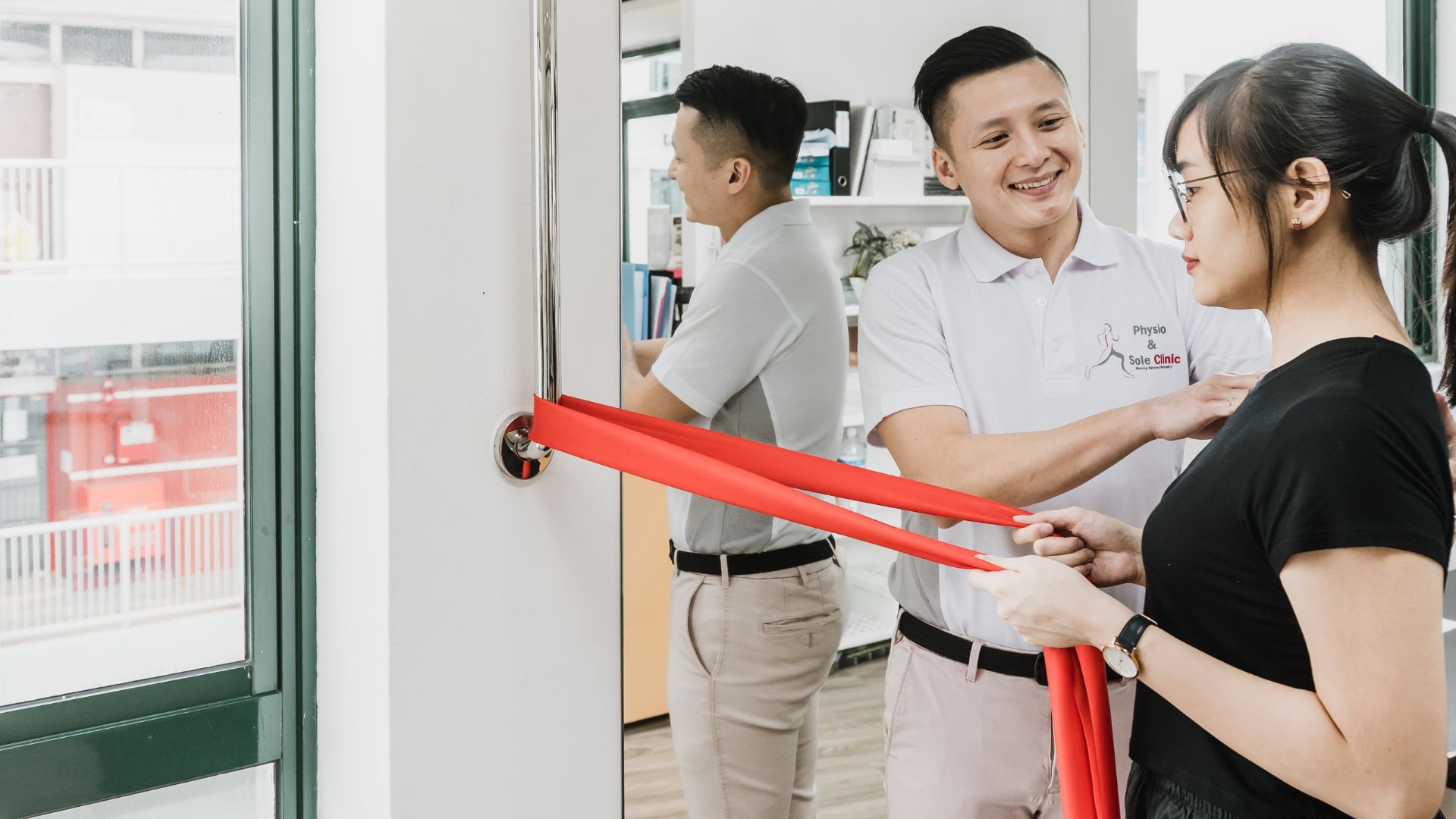Pickleball is quickly becoming one of Singapore’s favourite sports, attracting players of all ages. While it’s a fun and engaging way to stay active, the fast-paced nature of the game can put stress on your joints, muscles, and tendons, leading to injuries if not managed properly. So how can physiotherapy help you play pickleball safely and at your best? Let’s break it down!
What is Pickleball & Why Does It Lead to Injuries?

Pickleball is a fast-paced sport that combines elements of badminton, tennis, and table tennis. Played on a smaller court with a paddle and a perforated plastic ball, the game requires quick reflexes, rapid direction changes, and frequent lunges. While fun and accessible for all ages, these repetitive movements can put strain on key muscle groups and joints, leading to overuse injuries if proper conditioning and recovery aren’t prioritised.
What are some of the common injuries & their causes?

Due to the explosive movements, sudden stops, and repetitive paddle swings, pickleball players are at risk of developing:
- Rotator Cuff Injuries – Overhead smashes and repetitive arm motions can lead to shoulder pain and weakness.
- Tennis Elbow (Pickleball Elbow) – Caused by repetitive paddle swings, leading to forearm and wrist strain.
- Lower Back Strain – Frequent twisting and bending can put stress on the spine and lower back muscles.
- Knee Sprains & Ligament Injuries – Quick pivots and lateral movements increase stress on the knees, potentially leading to ligament damage.
- Achilles Tendinitis & Plantar Fasciitis – High-impact footwork can inflame the Achilles tendon or cause heel pain.
Who is at Risk of Pickleball Injuries?
While anyone can suffer from injuries, certain players are at higher risk:
- Older players – As muscles and joints weaken with age, injuries are more likely to occur
- Beginners – Those new to the sport may have poor technique or lack of proper warm-ups.
- Competitive players – Frequent play and overuse injuries are common in serious players.
- People with existing conditions – If you have past knee, ankle, or shoulder injuries, you are more prone to strain.
Where Do Pickleball Injuries Happen Most?

Most injuries occur in areas under high stress from quick movements, jumping, and impact:
- Upper Body (Elbows, Shoulders, and Wrists)
Repetitive paddle swings and improper form lead to conditions like pickleball elbow and rotator cuff injuries. - Lower Back & Core
Twisting, reaching, and improper posture can result in lower back strain. - Lower Limbs (Knees, Ankles, and Feet)
Sprinting, lunging, and abrupt stops can strain your knee ligaments, Achilles tendon, and Plantar Fasciitis.
Why Do Pickleball Injuries Happen?
There are several reasons why injuries occur in pickleball:
- Lack of Proper Warm-Ups
Jumping straight into a game without stretching increases injury risk. - Poor Footwear & Support
Playing in non-supportive shoes can lead to foot and knee issues. - Overuse & Fatigue
Playing too frequently without recovery leads to muscle strain. - Incorrect Technique
Poor paddle grip or improper foot positioning can cause wrist, elbow, and knee injuries. - Insufficient Strength & Flexibility
Weak muscles and tight joints increase the likelihood of strains and sprains.
What Are the Signs You Might Be Overtraining?
Overtraining happens when you push your body beyond its ability to recover, leading to fatigue, decreased performance, and an increased risk of injuries. Here are key warning signs that you may be overdoing it:
- Persistent Muscle Soreness & Fatigue
If your muscles feel sore for days and don’t seem to recover, your body may not be getting enough time to heal. - Declining Performance – Instead of improving, your reaction time, agility, or endurance may drop due to excessive strain on your muscles.
- Poor Sleep & Increased Irritability – Overtraining can affect your nervous system, making it harder to fall asleep and increasing stress levels.
- Frequent Illness – A weakened immune system due to overtraining can make you more susceptible to colds, infections, or general exhaustion.
If you notice these signs, take a break, adjust your training routine, and prioritise recovery before an injury forces you to stop playing.
How Can You Prevent Pickleball Injuries?
Here are 5 key tips to stay injury-free:

- Warm Up & Stretch – Always do dynamic stretching before playing to activate muscles.
- Wear Proper Shoes – Use court shoes with good grip and arch support.
- Strengthen Your Muscles – Focus on core, legs, and shoulder strength training.
- Improve Flexibility – Regular stretching prevents stiffness and improves range of motion.
- Take Rest Days – Give your body time to recover between games.
How to Recover Faster After a Pickleball Match?

Proper recovery ensures that your muscles rebuild, preventing soreness and reducing the risk of injury. Here’s how you can speed up the process:
- Cool Down & Stretch
Perform gentle stretches and mobility exercises after a match to prevent stiffness and improve flexibility. - Hydrate & Refuel
Drink plenty of water and replenish electrolytes lost through sweat. A protein-rich meal can also aid muscle repair. - Ice & Compression
If you experience swelling or joint pain, apply ice packs and use compression sleeves to reduce inflammation. - Prioritise Sleep
Quality sleep is essential for muscle recovery, hormone regulation, and overall athletic performance. - Foam Rolling & Massage
A post-game massage or foam rolling session helps break down tight muscle knots and improves circulation for faster recovery. - Active Recovery
Light activities like walking, swimming, or yoga on rest days can help flush out lactic acid and maintain mobility.
If pain persists or worsens after playing, a physiotherapy session can help address underlying issues and prevent long-term damage. Don’t ignore discomfort—your body will thank you later!
How Can Physiotherapy Help?

Physiotherapy helps prevent injuries, relieve pain, and improve performance for pickleball players. A physiotherapist corrects posture, movement, and muscle imbalances to reduce injury risks. If you’re already in pain, manual therapy, stretching, and strengthening exercises ease discomfort and restore mobility.
Beyond recovery, physiotherapy enhances strength, agility, and flexibility, ensuring your body can handle the sport’s quick movements. Proper technique correction minimises joint stress, while rehab exercises speed up healing and prevent re-injury, getting you back on the court stronger.
When Should You See a Physiotherapist?
If you’re experiencing persistent pain, stiffness, or swelling in your knees, elbows, or shoulders, it’s time to see a physiotherapist. Recurring injuries, limited mobility, or difficulty bending, stretching, or rotating joints can indicate underlying issues that need professional care. Ignoring these warning signs may lead to worsening injuries and longer recovery times, so early intervention is key to staying active and pain-free on the court.
Why Choose Physio & Sole Clinic for Pickleball Injury Prevention & Treatment?
At Physio & Sole Clinic, we understand the fast-paced nature of pickleball and the risks that come with quick movements and sudden stops. Our experienced sports physiotherapists specialise in treating and preventing injuries, ensuring you stay active and pain-free. We provide personalised treatment plans tailored to your pain, injury, and playing style, along with hands-on pain relief techniques like manual therapy and soft tissue release for faster recovery. Our strength and mobility programs help improve performance while reducing injury risk, and our sports-specific rehab ensures you return to the court stronger and more confident.






